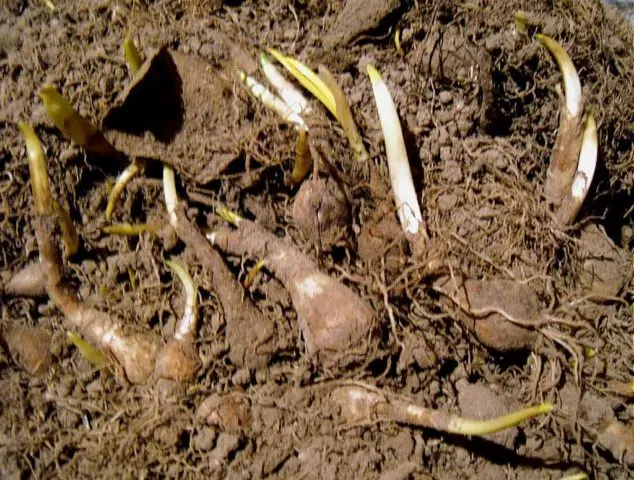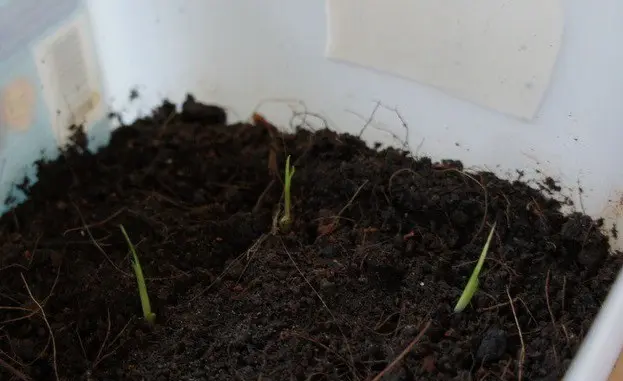Contents
Breeding irises does not cause much trouble. They begin to bloom the very next year, immediately becoming the main decoration of the garden. Irises reproduce easily, they quickly take root after separation and planting.
Features of reproduction of irises
The division of the bush must be carried out every 3-5 years, otherwise the flower will shrink
Tools for work must be clean. The place is dug up and freed from weeds, as they oppress flowers and block sunlight, which contributes to poor growth.
Iris is propagated 2-3 weeks after flowering. The procedure is carried out in dry weather. Divided fragments are planted in well-drained soil. Irises do not like rich soil and do not bloom in it, and excessively moist soil leads to rotting of rhizomes.
It is recommended to lay seedlings in the hole with their roots to the south so that they warm up as much as possible by the sun. This contributes to the appearance of young buds, which in a few years can be propagated by iris.
How garden irises reproduce
When choosing a method for propagating irises, it is important to consider the purpose of the procedure. For breeding flowers, it is better to use the vegetative method, because. culture will bloom the next year. The generative method (sowing seeds) is used to breed a new variety or cultivate wild species. In this case, flowering will come in 2-3 years.
The vegetative method includes:
- division of the rhizome;
- budding;
- propagation by sprouts and root cuttings.
Reproduction of irises by dividing the bush
The bush can be propagated by dividing its rhizome, bulbs or green sprouts.
Having dug up the rhizome, it is cut into several large parts, including at least one fan of leaves and two or three root links. Each of the divisions must be carefully examined, cut out rotten and outdated areas. Small roots are cut to a length of 10-11 cm, then the leaf part is shortened to 15 cm. The leaves are cut obliquely.

The rhizome is placed in a solution of potassium permanganate for 1,5-2 hours, dried, the cut points are treated with crushed coal. After 2-3 days, when excess moisture from the roots has evaporated, the delenki are planted in the ground.
To propagate valuable varieties, breeders recommend using budding. This method of reproduction gives about 50 units of planting material.
The rhizome of the most developed plant is cut with a sharp knife into segments with 2 roots and 1 bud, they are planted in a container. The container is transferred to a bright and warm room. Watered as needed. After the appearance of the first three leaves, irises are planted in a flower garden.
Small shoots left from the old bush should not be thrown away. They are used as much as possible for the propagation of irises, cutting off a cutting with several roots from the main rhizome. After drying the cut, the seedling is planted in the ground.
The most reliable method of reproduction is the separation from the mother bush of a non-flowering sprout with a small segment of the rhizome. Do it at the time of flowering. The sprout is planted in the shade, sprayed as necessary. The advantage of this method is that the mother plant is not damaged and the seedlings take root well.
Some varieties of iris are propagated by dividing the bulbs. They are carefully separated by hand.

The bulbs are placed in a cool room with a temperature not exceeding 10 ° C for 10-12 days, after putting them in a bag
This procedure contributes to the abundant flowering of irises. Before planting, the bulbs are disinfected with a solution of potassium permanganate. The hole is 1/3 covered with sand. The bulbs are not buried, otherwise the roots will not have enough heat and light. After planting, the iris must be watered.
Recommended dates
The best time to propagate irises by dividing the bush is summer and early autumn. They will have time to take root before frost, survive the winter well and will please with flowers next year. Holding an event in late autumn can kill plants.
In the northern regions, it is preferable to propagate irises in the spring, in the southern regions – in the fall.
Reproduction of irises by dividing the rhizomes is carried out in July, when the weather is warm. In hot soil, the growth and development of lateral shoots and the root system is inhibited, and susceptibility to rot is sharply reduced.
Reproduction by kidney flower growers recommend moving to the end of July so that they have time to ripen. Seeds are sown in early September.
How to dig and divide a bush
To avoid damage to the roots, plants are dug out of the flower bed with a garden pitchfork. Previously, the bush is carefully dug with a shovel – this will weaken the roots and it will be easier to remove it from the ground.
Bulbous irises are divided by hand, rhizome – with a sharp knife, which is repeatedly disinfected in a solution of manganese. It is allowed to break the rhizome manually, the percentage of its damage in this case is much lower.
Reproduction of irises by budding is carried out with a knife. The rhizome is cut into many segments with buds, which are then planted in a planting container.
When propagating by budding, more planting material is obtained than with other methods.
The cuttings are separated with a knife, choosing small shoots from the plant. They are cut off, capturing a piece from a rhizome with several thin roots.
Sprouts are obtained during flowering by cutting off a fragment from the bush that does not have a bud with a piece of rhizome. Planting material is planted after 5-7 days, when the sections heal.
Landing in a permanent place
Plant irises in sunny areas. If the earth is clay, then the beds should be raised. The roots of the flower grow strongly, so the holes are formed at a distance of 40-60 cm. The bottom is filled with sand.
Before planting, the leaves are cut with a fan and planted in the ground, making sure that they are directed in the direction of the sun. The rhizome should be slightly above ground level so that the bud is on the surface.
The rhizome, buried in the ground, suffers from a lack of sunlight, which leads to its decay.
Saplings lightly sprinkled with soil are watered. To ensure oxygen access to the roots, the soil is loosened.
The formation of a liquid fan of leaves in plants after reproduction indicates the weakness of flower buds, which means that the iris will not bloom next spring.
The cuttings are planted in a shallow hole, at the bottom of which ash mixed with earth is poured. The stalk is placed in the hole, watered and sprinkled with soil, lightly tamping it on top.
Iris sprouts and bulbs are planted in soil mixed with sand. The hole is covered with earth and crushed around the stem. Seedlings are watered and loosened.
Reproduction of irises by seeds
Iris reproduces not only vegetatively, but also by sowing seeds, but this is a longer and less reliable process. You can use the seed method for irises of all varieties.
Iris seeds are formed in trihedral seed pods, ripening occurs 2 months after flowering
Collect them from the plant yourself. The seed box formed after the flowering of the iris is enclosed in a gauze bag and left until ripe.
The resulting material is used in the same autumn or next spring. It should be stored in a dry and cool place.
Before planting, iris seeds are soaked for 2-3 hours in a weak solution of potassium permanganate or in an antifungal drug to protect plants from diseases. Then they are sown in prepared pots or containers.
Disadvantages of the seed method:
- when propagated by seeds at home, there is no guarantee that the iris will inherit varietal characteristics;
- plants will delight with flowers in 2-3 years, and with the vegetative method they bloom the next spring.
Sowing seeds directly into the ground
Ripe seeds in a flower garden are sown in September, in slightly moistened ground. Observe the distance between rows – 20-25 cm, and between plants 10-11 cm. The depth of seeding – 2 cm. The crops are not watered. For the winter, it is recommended to cover the flower garden with spunbond or dry leaves.
Seedbed method
The advantage of the seedling method of propagation of irises is that there is no need for thinning seedlings.

Seeds left in storage are sown for seedlings in winter
Process algorithm:
- In January, iris planting material is taken out of storage, wrapped in a damp cloth, placed in a closed container and put in the refrigerator for 1 month.
- In February, they are sown in peat pots, after soaking them in water for 3-5 days.
- 30 minutes before sowing, the water is drained and the seeds are dried.
- Planting soil is prepared: peat, perlite, sterilized compost in a ratio of 2:1:3.
- Prepared iris seeds are sown in containers to a depth of 2 cm.
- The container is taken out into the open air. Before cold weather, the seeds are regularly (but not strongly) watered. Excessively moist soil contributes to the decay of the root system of the iris.
- For wintering, crops are left in an unheated room. Low temperatures will not harm them, they will only fall into “hibernation”, and germinate in the spring.
- After the emergence of seedlings, the containers are moved to a sunny area, where the plant will have enough heat and light, and in May, the seedlings are transplanted into a flower garden.
Care of irises in the process of reproduction
Having finished the breeding process, the irises are watered. The next moistening of the soil is organized after 3 days, allowing the soil to dry out a little. The earth is regularly loosened, preventing the appearance of a crust. Weed weeds so that they do not interfere with the development of the root system.
In August, irises are recommended to be sprayed with copper sulphate (at the rate of 50 g per 5 liters of water). Processing prevents darkening of the leaf mass of plants.
Before wintering, the bare roots of iris are sprinkled with peat and garden soil. Varieties sensitive to cold are sheltered for the winter. When the snow melts, the insulation is removed.
Conclusion
Irises reproduce in various ways. Use the methods of dividing the bush, sow seeds for seedlings or immediately in open ground. Subject to the rules of planting and care, even a beginner in garden matters will cope with the breeding process.









